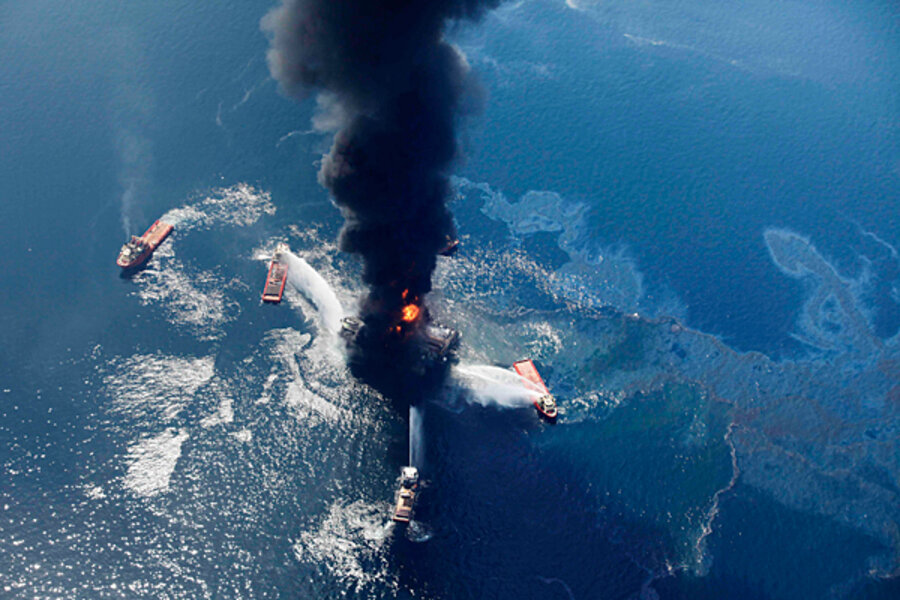Ecological risk grows as Deepwater Horizon oil rig sinks in Gulf
Loading...
| Atlanta
Up to 7,400 barrels of crude oil a day could be spewing into the depths of the Gulf of Mexico after Tuesday night's explosion aboard the semi-submersible Transocean Deepwater Horizon rig caused it to capsize and sink Thursday morning.
After listing for most of Wednesday, the $600 million platform 41 miles off the coast of Louisiana sank in 5,000 feet of water at about 10 a.m. Thursday. Seventeen people were injured, and 11 are still missing from the explosion. The rest of the crew of 126 filed into lifeboats or jumped nearly 100 feet from the platform before being pulled from the water by Coast Guard rescue crews.
As the intense fire burned the spewing oil off on Wednesday, early indications were that the rig fire didn't present significant danger to the coastal ecosystem. But with the rig now sunk and the fire out, concerns are now growing that the situation could mirror a deep-water spill caused by a fire on the West Atlas rig off Australia last year, which environmentalists likened to a "disaster movie."
IN PICTURES: Louisiana oil rig explosion
"This is already a serious accident, and if this crude is allowed to flow uncontrolled out of the well for days or weeks, the environmental impact could be really substantial," says Robert Bryce, an energy expert at the Manhattan Institute and author of "Power Hungry: The myths of 'green' energy and the real fuels of the future." "They now have to figure out how to stop the blowout from the well. There are a tremendous number of unknowns now."
Coast Guard officials estimated that up to 13,000 gallons of crude an hour was coming out of the exploratory hole 41 miles offshore of Plaquemines Parish, La. An early suggestion that damage would be minimal because the fire was consuming most of the fuel "does have the potential to change," BP official David Rainey told the New York Times.
A BP spokesman told reporters that contractors using remote-controlled submarines (ROVs) are on the scene attempting to plug the well pipe via something they called a "hot-stabbing" operation. Early efforts to plug the well were unsuccessful, BP reported.
The Coast Guard is also reporting that it is assembling environmental cleanup crews. "We are looking at dispersant options, and we have planes and vessels on standby, should it be necessary," Coast Guard spokeswoman Sue Kerver told the oil and gas industry newspaper Upstream.
The viscosity of the leaking crude could determine whether it floats to the top or becomes an underwater slick. A two-mile surface slick has been spotted flowing from the site, but it is not yet clear whether that originated from on-board diesel fuel or well oil.
On Thursday, lawyers filed a federal negligence suit on behalf of the 11 missing crew members against BP and Transocean. Transocean, an exploratory company based in Geneva, is leasing the rig to BP for $500,000 a day. Both companies are on the forefront of deep water exploration.
The explosion, fire, and leak have put new focus on the Obama administration's decision to open up more deep water zones in the Gulf for oil exploration. Sen. Mary Landrieu (D) of Louisiana called for a swift and thorough investigation.
"It is critical that [federal] agencies examine what went wrong and the environmental impact this incident has created," Sen. Landrieu said in a statement. "These findings should be reported to Congress as soon as possible."
Added Rep. Jim Costa (D) of California: “This incident is a grim reminder of the risks involved in developing public energy resources off America’s shores."
Even without the possible environmental damage, the Deepwater Horizon accident is likely to be the worst US offshore oil rig disaster since 21 crew members were killed in a blowout on a Gulf drilling barge in 1964.





